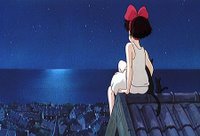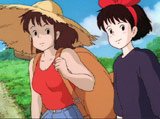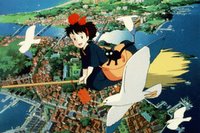 To those not in the know or quick to judge, Majo no Takkyuubin (Kiki's Delivery Service) is a nothing more than a girly tale of a witch going to a city to continue her training. For those who are willing to look a bit deeper however, one of the best coming-of-age stories emerges.
To those not in the know or quick to judge, Majo no Takkyuubin (Kiki's Delivery Service) is a nothing more than a girly tale of a witch going to a city to continue her training. For those who are willing to look a bit deeper however, one of the best coming-of-age stories emerges.I first saw Kiki in 2003 at a free screening to celebrate the UK DVD launch. I went with my now-housemate and we both loved it. As the story starts, we find Kiki listening to her radio in the countryside. When she hears that the skies will be clear she decides to leave for her training year a week early. Her parents are sad to see her leave but support her as best they can. Leaving with only her broomstick, her father's radio and talking black cat Jiji she soon finds a seaside city, Korico, but her initial joy soon lessons as she finds the city folk, less than interested in her dramatic arrival, very indifferent to her presence. A chance encounter with the kindly (and heavily pregnant) baker Osono affords her her first friend and a room to live in. Kiki's only "skill" is flying so she decides to set up an express delivery service.
 At first she struggles to find customers and even when she does, her first delivery is blighted by a small problem (loosing the package), but with the help of Jiji she successfully completes her assignment and makes another friend in the form of the easy-going artist Ursula. Gradually, Kiki makes more friends in the form Osono's husband Okino and, after an initial unease, local amateur pilot-in-waiting Tombo. However, she is still shy and uneasy around others so as she gets to know Tombo, his friends scare her off. Finally after a delivery to a rude customer causes her to miss a party and get her soaked through, Kiki wakes up the next day feeling terrible. Her illness turns to panic as she suddenly can't understand anything Jiji is saying and then discovers her powers of flight are failing. Osono urges Kiki to take some time off. It's at this point that Ursula pays Kiki a visit and convinces her to go and stay with her in the woods. It's here that Ursula tells Kiki about the time when she "lost" her painting ability. Kiki returns to Korico and resumes her deliveries on foot. A storm causes a series of events that puts one of Kiki's friends in danger. Kiki must now find the self-belief to reacquire her flying skills to help her friend.
At first she struggles to find customers and even when she does, her first delivery is blighted by a small problem (loosing the package), but with the help of Jiji she successfully completes her assignment and makes another friend in the form of the easy-going artist Ursula. Gradually, Kiki makes more friends in the form Osono's husband Okino and, after an initial unease, local amateur pilot-in-waiting Tombo. However, she is still shy and uneasy around others so as she gets to know Tombo, his friends scare her off. Finally after a delivery to a rude customer causes her to miss a party and get her soaked through, Kiki wakes up the next day feeling terrible. Her illness turns to panic as she suddenly can't understand anything Jiji is saying and then discovers her powers of flight are failing. Osono urges Kiki to take some time off. It's at this point that Ursula pays Kiki a visit and convinces her to go and stay with her in the woods. It's here that Ursula tells Kiki about the time when she "lost" her painting ability. Kiki returns to Korico and resumes her deliveries on foot. A storm causes a series of events that puts one of Kiki's friends in danger. Kiki must now find the self-belief to reacquire her flying skills to help her friend.
The beauty of this film is that it truly has relevance for every age group. For people who have left home, the biggest story is the emotional trauma of leaving home. Even though Kiki is excited to leave and can't wait to find her city, she soon finds that it isn't everything she wanted and that the shadowy truth of what it's like coping by yourself, especially in a new town, isn't easy. Finding yourself seemingly alone in a strange place is when you start to doubt yourself and in Kiki's case, it just takes a few things to go wrong before her self-doubts cause her to loose her "magic". The happy outcome is that she realises that she does have friends, who look out for her and help as best they can. By casting Kiki as a 13 year old girl, Miyazaki doesn't hammer home the modern day reality of leaving home. In the introduction to The art of Kiki's delivery service, Miyazaki writes, "... At one time the main characters of stories for young people gained financial independence, which was then equal to spiritual independence, after struggling through difficulties. In today's society, however, where anyone can earn money going from one temporary job to another, there is no connection between financial independence and spiritual independence. In this era, poverty is not so much material as spiritual.
In an era when leaving the security of one's home is no longer anything special, and living among strangers means nothing more than going to a convenience store for anything you need, it might be more difficult than ever to achieve a real sense of independence since you must go through the process of discovering your own talents and expressing yourself."
 An important character is that of Jiji. He is both important in terms of the story and highlighting, once again, the difference of storytelling in the West and Japan. In the Japanese version, Jiji is a guide or guardian for Kiki. He only speaks occasionally and offers Kiki advice. In the Disney dub, Jiji - voiced by the late Phil Hartman - is a loudmouth wisecracking cat, with extra dialogue inserted to make him fit more with the wacky sidekick that US audiences are used to. The most important difference is that at the end of the film, in the US dub, Kiki can once again understand Jiji, where as in the Japanese dub, she can't and it is implied that Kiki has grown in character past the point where she needs Jiji to guide her. Similarly, the radio which acts as Kiki's reminder of home plays a different role in the different dubs. In the US dub, it's just a radio that plays constantly in the background, but in the Japanese dub, the radio is in Japanese as the film opens but when she arrives in Korico all the broadcasts are in a foreign language to her, hammering home her feeling of isolation as now even her keepsake from home has "turned" on her.
An important character is that of Jiji. He is both important in terms of the story and highlighting, once again, the difference of storytelling in the West and Japan. In the Japanese version, Jiji is a guide or guardian for Kiki. He only speaks occasionally and offers Kiki advice. In the Disney dub, Jiji - voiced by the late Phil Hartman - is a loudmouth wisecracking cat, with extra dialogue inserted to make him fit more with the wacky sidekick that US audiences are used to. The most important difference is that at the end of the film, in the US dub, Kiki can once again understand Jiji, where as in the Japanese dub, she can't and it is implied that Kiki has grown in character past the point where she needs Jiji to guide her. Similarly, the radio which acts as Kiki's reminder of home plays a different role in the different dubs. In the US dub, it's just a radio that plays constantly in the background, but in the Japanese dub, the radio is in Japanese as the film opens but when she arrives in Korico all the broadcasts are in a foreign language to her, hammering home her feeling of isolation as now even her keepsake from home has "turned" on her.Again, Miyazaki's love of flying features heavily (as it would for a film about a flying witch). The setting returns to a faux-European setting, blending in parts of the Med but also Stockholm and also uses an alternate timeline (set in the 50s as if WW2 never occurred). As with most Ghibli films, the film has an uplifting message and out of everyone I've shown this film to, without exception, all have loved it. It's a great way to get into the world of Ghibli and possibly the perfect film to watch if you ever feel alone and out of place.

No comments:
Post a Comment